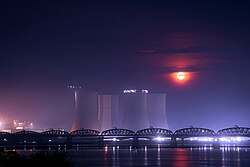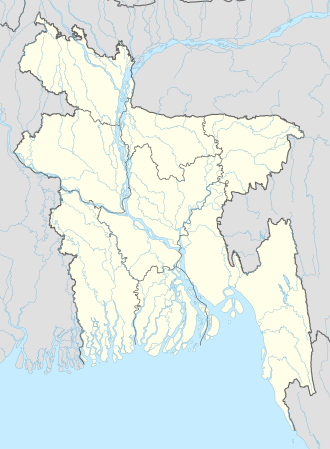Nuclear power in Bangladesh

Bangladesh first conceived building a nuclear power plant in 1961. The Bangladesh Atomic Energy Commission was established in 1973. The country currently operates a TRIGA research reactor at the Atomic Energy Research Establishment in Savar.[1]
More recently, in 2001 Bangladesh adopted a national Nuclear Power Action Plan.
In February 2011, Bangladesh reached an agreement with Russia to build the 2,400
The inter-governmental agreement (IGA) was officially signed on 2 November 2011.[4] Estimated cost of the contract is US$12.65 billion.[5][6] As per the Revised Annual Development Programme for 2024-2025, a total of BDT 73,746.06 crore had been spent on the project by June 2024.[7]
On 29 May 2013 Bangladesh's Prime Minister declared that a second 2 GW nuclear power plant will be constructed in the southern region of the country. In 2019, site selection was still in progress, with a focus on the coastal region at the Bay of Bengal.[8][9]
Bangladesh received the first shipment of uranium fuel from Russia for its first nuclear power station in October 2023, making it the world's 33rd nuclear energy producer.[10]
Background

For Bangladesh, which is a historically agrarian country, the agricultural sector has shrunk from over 30% in the 1980s to under 20% a decade into the millennium. On the other hand, industry is growing from under 20% in the 1980s to over 30% currently. With highly industry national economy, the generation of electricity will be linearly related to the national GDP. With less agriculture and more industry, not only will more emissions be given off into the atmosphere, but lack of trees and plants will hinder any chance of carbon sequestration.[11]
The underdeveloped and mismanaged energy infrastructure of Bangladesh has inhibited economic growth (See:
Current energy sources
The main national source of energy is in its natural gas reserves. 55% of this goes to the power generation sector while 27% goes to factories and industry, 10% to household purposes and 5% in the automotive sector. Furthermore, the government has a targeted six 5-year plans from 2010 to 2021 in which it would try to produce 8,500 MW in 2013, 11,500 MW in 2015 and 20,000 MW by 2021. It is a part of the ‘Digital Bangladesh’ scheme's Vision 21 where the government would seek universal electrification around the nation. The plan also targets an increase in domestic and important coal based power plants, and more on-shore or off-shore gas exploration. Ruppur Nuclear Power Plant Implementation Project (RNNP) is also one such scheme to reach an addition capacity of 9000 MW.[11]
Currently, around 88% of energy used for power generation is from natural gas sources and 4% from coal, 6% from oil and just 2% from
Waste disposal
There are arguments in favour of nuclear energy when compared to the use of coal.
Nuclear waste disposal will be managed by Radioactive Waste Management Company, to be formed according to Bangladesh government's National Policy on Radioactive Waste and Spent Nuclear Fuel Management-2019.[13] Bangladesh plans to store nuclear waste for a given period, after which the waste will be sent to Russia.[13] Spent fuel may be reprocessed in Russia for fast breeder reactors.[14]
Costs
There are also different transport requirements for nuclear fuel and fossil fuels in the context of Bangladesh. Transportation costs are much higher for coal and oil systems at 20,000 train cars or 10 supertankers, compared to a nuclear plant at just 3–4 trucks. Around the world, there are projected to be around 860 nuclear power plants[
As of 2018, the estimated cost for waste management, disposal, and decommissioning has not been released.[14]
Disaster management
According to the 4th
See also
References
- ^ "Atomic Energy Research Establishment". Atomic Energy Research Establishment. Archived from the original on 23 October 2017.
- ^ "Emerging Nuclear Energy Countries". World Nuclear Association. April 2009. Retrieved 22 April 2009.
- ^ "Bangladesh To Build Nuclear Power Plant". Energy Daily. 24 June 2007. Retrieved 15 July 2007.
- ^ Chowdhury, Syed Tashfin (5 November 2011). "Bangladesh, Russia sign nuclear plant deal". Asia Times. Archived from the original on 5 November 2011. Retrieved 7 November 2011.
- ^ "Russia to get Rooppur loan payments via Sonali Bank account". The Business Standard. 5 December 2024. Archived from the original on 5 December 2024. Retrieved 2 April 2025.
- ^ "Annual Report 2019-2020" (PDF). Economic Relations Division (Bangladesh). 2 April 2025. Retrieved 2 April 2025.
- ^ "Revised Annual Development Programme of 2024-2025". adp.plancomm.gov.bd. Archived from the original on 8 March 2025. Retrieved 2 April 2025.
- ^ http://www.kalerkantho.com/?view=details&type=gold&data=news&pub_no=1258&cat_id=1&menu_id=43&news_type_id=1&index=3> [dead link]
- ^ "Nuclear Power in Bangladesh (October 2022)". Retrieved 17 November 2022.
- ^ "Bangladesh gets first uranium shipment from Russia for nuclear power plant". www.aljazeera.com. Retrieved 20 October 2023.
- ^ ISBN 978-3-8465-9333-2.
- PMID 35044606.
- ^ a b "Bangladesh Govt approves Nuclear Waste Management Policy". NuclearAsia. 23 October 2019. Retrieved 3 July 2020.
- ^ a b Rahman, Mowdud; Sarker, Debasish (2 February 2018). "Nuclear power: Surviving on secrecy and misinformation". Daily Star. Bangladesh. Retrieved 3 July 2020.
External links
- Bangladesh Atomic Energy Commission – Official Website

